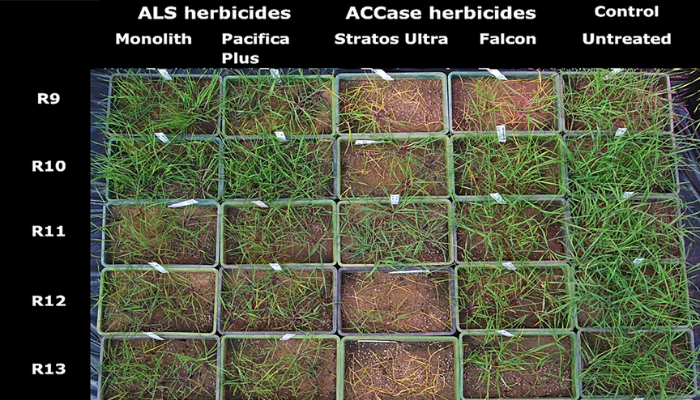20 December 2022
Grass weeds and herbicide resistance in crop production

Vijaya Bhaskar AV and Dermot Forristal, Teagasc, summarise their recent research which focused on grass weeds and herbicide resistance in crop production.
The survey found that grass weeds have increased on Irish tillage farms due to increases in winter cereals and non-inversion tillage adoption, and also new weed introductions. The loss of herbicides due to tighter regulation and increased herbicide resistance have also contributed. We needed to quantify these changes so we surveyed growers from the east and south in 2020 and again in 2021. The survey included 62 growers with plough-based tillage and 41 with non-inversion tillage.
Grower demographics, their concerns about grass weeds and the use of different weed control strategies were recorded by questionnaire; while grass weeds were quantified by careful assessment using a 24m x 24m grid sampling technique within a 4ha area within growers’ fields, prior to harvest in each of the two years. Seed samples were collected for herbicide resistance testing. The key results from this survey are:
- Non-inversion tillage was associated with larger farms and younger growers with more formal education
- Most of the growers were aware of herbicide-resistant grass weeds (>80%) and most (>90%) used integrated weed management (IWM) practices to some extent
- Across the 103 farms, bromes (on 62% of farms) and spring wild oats (56%) were the most prevalent with 8% of the bromes resistant to the ALS type herbicides normally used for control and 10% of the wild oats resistant to commonly used ACCase herbicide types. Italian ryegrass (13%) and black-grass (16%) were found on fewer farms but with higher resistance risks; 56% of Italian ryegrass populations and 43% of black grass populations resistant to ACCase and/or ALS herbicides.
- Over 85% of those using non-inversion tillage used crop rotation compared to about 56% of those who ploughed. Cover crops were used by 71% of those who practiced non-inversion tillage compared to 19% of those who ploughed. Herbicide use was similar in both systems.
- In spite of greater adoption of IWM practices, non-inversion tillage farms had significantly higher population pressure based on weed scores for bromes and Italian ryegrass compared to those who ploughed.
This research paints quite a worrying picture for the control of grass weeds in cereals. It confirms:
- Black grass is now a serious threat to Irish crop production;
- Bromes, wild oats and Italian ryegrass create an increasing challenge particularly when coupled with herbicide resistance evolution.
- Non-inversion tillage particularly when coupled with earlier sowing increases the grass-weed threat.
While IWM is being practiced to a limited extent, considering the weed and herbicide resistance challenges, there is an urgent need to develop effective IWM for all crop production systems. This survey, in addition to identifying these challenges, has also set a useful baseline, from which future change can be measured. This will help us monitor the challenge of difficult-to-control weeds and the effectiveness of integrated weed control measures.

Figure 1: Control levels achieved in sensitive and resistant (R9 to R13) populations of black-grass with different ALS and ACCase herbicides.
A comprehensive scientific paper outlining grass weed occurrence and herbicide resistance status has just been published by Vijaya Bhaskar and his colleagues at Oak Park https://www.frontiersin.org/articles/10.3389/fagro.2022.1063773/full
